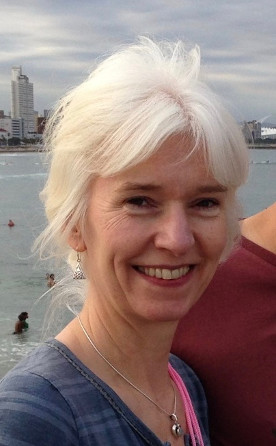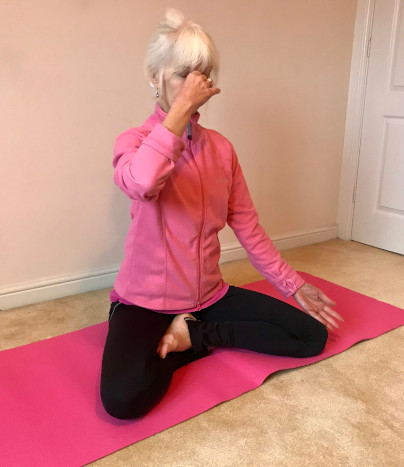Autumn Seminar Saturday 21st November 2020 with Felicity Leigh
Report by Judith Lynch

An excellent CYTA seminar via Zoom was led by British Wheel of Yoga Diploma Teacher Felicity Leigh. On 21st November 31 lucky participants enjoyed a 3-hour session entitled: “Importance of Sangha – how we can continue to come together while we must stay apart?”
The morning’s programme was well planned and structured. There were many elements to the event but they were integrated across the whole session. Discussion was followed by a thorough asana practice which then flowed into pranayama exercises, meditation, chanting and relaxation. There was something for everyone to enjoy. Indeed as one student said to Felicity at the end:
“A lovely way to spend a Saturday morning.”
We started with a definition of Sangha and how important it is to stay in touch with like-minded people, especially at this time when we can see so few people face-to-face. A few participants talked about the value of keeping in touch and their appreciation of the technology, including the telephone, to facilitate regular contact with our friends and relatives and to keep in touch and develop ourselves within our yoga community. This Zoom workshop gave us an opportunity to feel connected with each other as we practised on our separate mats at home.
After a centring exercise we worked with a range of interesting, gentle warm-up movements to check out how our joints, muscles and particularly our spine were feeling. Felicity encouraged us to stay in touch with our breathing rhythm and pace and to work to synchronise the movements with the breath, where appropriate. We also built up some of movements by increasing the number of breaths to gradually extend the length of the hold in postures.

We moved onto tadasana, or samasthiti and Felicity reminded us all of the concepts of sthira and sukha. We were asked to think about creating a balance between these two things as we worked through our asana practice. She reminded us that Patanjali’s “Yoga Sutra” describes asanas as having these two important elements. Sthira: steadiness/ stability i.e. the ability to hold body energy and mind in balance for extended periods, the effort to maintain a posture. Sukha is about comfort in a posture i.e. ease to experience spaciousness in the body. As we practised Felicity described tadasana as “attentive standing”, balancing sthira and sukha, i.e. creating support and stability to experience space. She also encouraged us to come back to tadasana briefly, between other standing postures – an example of excellent practice.
From tadasana we moved onto a simple side bend, noting the expansion of the intercostal muscles to help deepen breathing. This was followed by a simple twist which then became the first movement of a shortened version of the sun salutation. A new addition to me but a perfect way to cover moving the spine in other directions to complement the forward and back bends of Surya Namaskar. We then added on postures until we had built up to practising the full round of a sun salutation. Felicity encouraged us to make any modifications we needed and to care for ourselves. She shared her rule of thumb: If it hurts now, or later, then don’t do it. The warrior postures were more challenging but again built up incrementally. Warrior 1 was practised dynamically, with straightened knee and raised arms, using the breath for support. Warrior 2 was a little stronger as we were encouraged to hold the posture for a number of breaths, feeling the lines of energy from the shoulders, down the arms and through to the fingertips. Warrior 3 was the hardest for most people perhaps. However Felicity demonstrated her way to access the posture, with alternative arm positions offered. She also asked us to particularly make sure we considered the sukha by lengthening the spine and keeping the chest open, as well as the necessary stability (sthira) of the balance. I found one advantage of my limited space practising at home was that I was close to a wall to help with wobbling in this pose! We were guided to focus on the sense of strength and positivity the warrior poses offer which is so useful at this difficult time. We were also reminded to link the breath and the movement and to balance the sthira and sukha in each asana.
Seated we came into the staff posture and from there we practised Janusirsasana. With raised arms we did a couple of quick practise fold forward to ease into the movement. In the full posture we were encouraged to continuing softening forward on each exhalation straightening the spine on each inhale. We returned to staff posture briefly between sides. As on the completion of other postures Felicity encouraged us to reflect for a moment on the impact of the posture and how it felt for each of us.
An alternate nostril breathing sequence followed. It was gradually extended so that we acknowledged, and later controlled, the length of different parts of the 4 -part breath and then returned to the simpler version of this pranayama practice. This led smoothly into a short savasana allowing us time to soften and relax before a short comfort break.

Part 2 focussed on sound and meditation but Felicity also integrated a little extra movement. We practised an extended cat movement, starting from a high kneel position and sounded the 3 parts of Om on each exhalation. A “caring breath” sequence was very soothing. This tied in beautifully with the theme of the meditation exercise: (Moving towards) Loving Kindness. It covered mindfulness (using the breath as support) compassion and self compassion. We were guided to be in the doorway to ourselves – looking neither outward nor inwards. As we sent out our love and compassion to others and to ourselves we were asked to reflect on how this felt. Were we aware of its effect in any particular part of the body? How did it affect our breathing? I found it a powerful mediation.
Felicity introduced us to a relatively short and simple Vedic chant, plus its translation. She led us through and then we repeated the stanza together. It was appropriate in its sentiment for our present predicament. A good way to return to the Sangha theme, although technical interference online did not unfortunately allow us to create the lovely echo effect we might have achieved in a venue.
After some quick stretches we completed the morning’s activity with a full relaxation which was a sort of cross between the “tense and relax” technique and yoga nidra.
It was certainly a wonderful seminar overall. As one participant fed back to me afterwards:
“A really thorough and invigorating yoga session from Felicity”
This level of appreciation was reflected during the feedback which rounded up the morning. Student teachers said they really enjoyed the different ways of accessing postures and the variety of warm-ups offered. A teacher said how much she enjoyed being reminded of the yoga principle of “attention without tension”
Many thanks go to Felicity for a well-rounded and stimulating workshop. Thank you to all who attended, especially if this was their first Zoom experience. Thank you to the CYTA Committee, especially Sue Hargreaves, for facilitating the session.
If you would like to see and download Felicity’s class notes please click on the link below:
